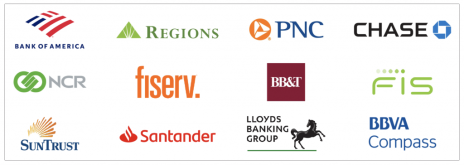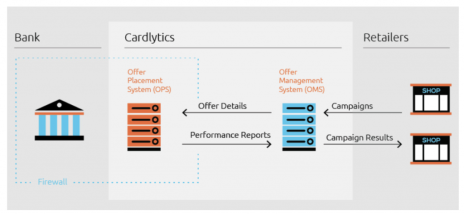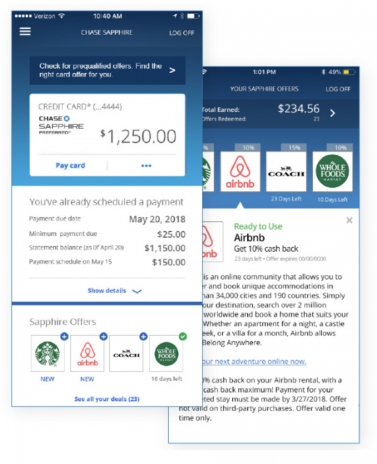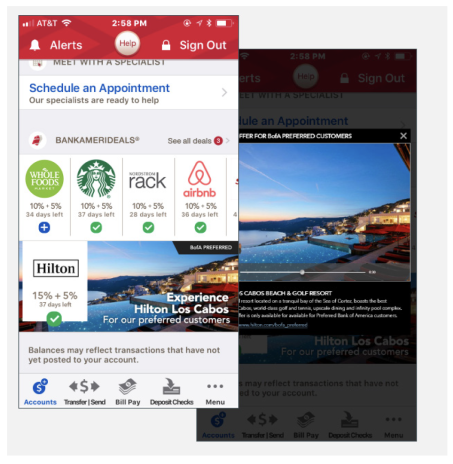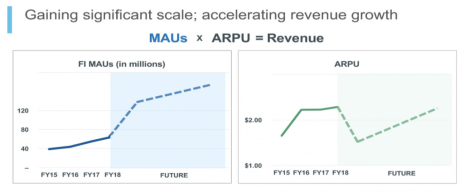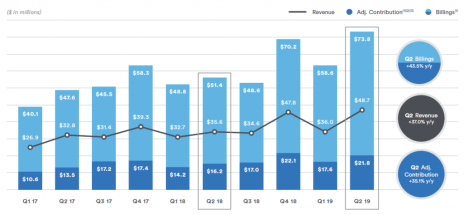What happens when you implement a digital marketing platform within secure online banking and mobile banking channels? Is that even possible?
The short answer is yes, it’s possible … if you can get banks to sell you their transaction data, host your platform and accept the revenue share agreements you propose for all the deals that consumers accept while logged in.
This month’s Cabot Small-Cap Confidential stock has created such a platform, and it’s taking off.
The story, and potential, of what happens when digital marketing and fintech walk down the aisle together is inside.
Cabot Small Cap Confidential 244
[premium_html_toc post_id="185953"]
THE BIG IDEA
I have vague memories of the Electrolux vacuum salesman coming to our house to sell his wares. Over the last 40 or so years, the basic idea of enticing people to take advantage of a “deal” hasn’t changed much. But the medium and tactics certainly have!
The biggest changes have come about because of digital marketing. Marketers can now reach people around the globe with campaigns designed from the palm of their hand, not door-to-door house calls.
Digital marketing is where the action is at. Digital media spend is increasing by 10% to 15% a year and is now well over $200 billion.
Marketers can now reach nearly 4.5 billion active internet users around the globe – almost 60% of the world’s population. They are super engaged. Google Trends shows that interest in Digital Marketing is now, literally, as high as it’s ever been!
With so many engaged internet users, digital marketing tools help brands create incredibly creative and impactful campaigns that can yield big results, very quickly.
They can also totally flop.
As the internet, data usage, analytics and consumer trends evolve the marketing tactics required to reach the right audience at the right time with the right offer have become increasingly sophisticated.
Marketers must be careful where they spend their dollars. And they need to measure the results to make sure they’re getting a reasonable ROI. That can be tough to do given that around 90% of consumer spending still occurs in stores.
The good news for marketers is that over 70% of payments in the U.S. are now made electronically, by debit cards, credit cards, ACH or bill pay. All that transaction data is held by financial institutions.
If only there were a way to access, analyze and pass that data on to marketers, in an easy-to-use and actionable format, I bet they’d be willing to pay for it!
Enter Scott Grimes and Lynne Laube. Two Capital One bankers who understood that marrying banking and marketing data could create huge value for banks, businesses and consumers.
As the story goes, the duo was kicking back one day joking about the types of customers Capital One had, based on their card-transaction data.
A lightbulb went off and a business was born.
The business they started in 2008 is all about the power of Purchase Intelligence, which is intended to make marketing more relevant and measurable.
Their company, Cardlytics, went public last year. It’s the only pure-play advertising platform that’s hosted within online banking and mobile banking platforms. Growth is accelerating, positive earnings are on the horizon, and the stock’s trend is undeniably strong.
In short, it’s an exciting opportunity to get in early on a scarce asset! Here’s the full story.
THE COMPANY
Cardlytics is an $810 million market cap company that has developed a purchase intelligence platform that is in the early innings of being adopted by major financial institutions (FIs) in North America (88% of revenue) and the U.K. (12% of revenue).
The company went public in February 2018. But it’s been signing up major financial institutions since 2012. It started with Bank of America, then announced a deal with Chase in 2018. That program continues to roll out now. Up next is Wells Fargo, which management says will start to roll out in Q4 2019. In the U.K. both Lloyds and Santander have been live for over five years.
How does the platform work and why are these financial giants jumping in?
It’s not rocket science. In fact, the relative simplicity of Cardlytics’ platform is what makes it so enchantingly sophisticated.The platform pulls in and analyzes trillions of dollars of raw purchase data (debit, credit, ACH, bill pay, etc.) from millions of accounts at thousands of FIs. That data is then run through a machine-learning technology which spits out a view of where and when consumers are spending their money.
Advanced analytics are then applied to the anonymized purchase data to turn it into something of value that Cardlytics can sell to marketers.
These marketers, which include brands we’re all familiar with across the retail, restaurant, subscription service, travel, grocery, luxury and E-Commerce channels, use the data to identify, reach and influence huge numbers of potential buyers with customized offers.
The distinguishing attribute of the platform, and major source of competitive advantage relative to other marketing platforms, is that Cardlytics reaches consumers directly through their online banking platforms and mobile banking apps.
That means consumers should be open to very specific offers from businesses they have purchased from in the past, in the precise moments when they are actively thinking about their finances. Also, the embedded offers have immediate credibility since most consumers already have a high level of trust in their financial institution’s platform.
In a typical scenario a consumer will see an offer of 5% off or 10% off from brands that they’ve purchased from before, or which fit their profile.
For example, while writing this I just logged into my Chase mobile banking app. I saw a 10% offer with seven days left for Dunkin’ Donuts. I accepted it. If I go to Dunkin’ Donuts soon, I’ll save 10% (up to $3.00, which is fine; I’ve never spent $30 at DD before!). If I don’t go, no problem - it doesn’t cost me anything and there’s no pressure, other than the seven-day limit.
Cardlytics pitches the platform as a win-win-win.
Banks win because they get reliable revenue – roughly 50% of revenue is shared with the banks – and have more active and engaged customers. Cardlytics’ data shows that, after accepting and using their first offer consumer spending goes up by 13%. Online banking logins go up by 17%.
Customers win because they save on everyday purchases that they want to make, in a secure environment. And marketers win by reaching engaged and receptive audiences, and they can measure the results of their efforts.
Does it Work?
It seems to. Cardlytics says that for every dollar a business spends on a marketing incentive it generates $30. This calculation is qualified by defining the consumer’s action as having been exposed to an incentive through its banking channel and subsequently making an online or in-store purchase during the campaign period. It’s a broad but still reasonable way to look at return-on-advertising dollars.
The concept passes the sniff test – if you send deals to a person who’s purchased from a certain business before, they will probably accept the deals and continue to purchase in the future. Deals from businesses that fit their spending profile will probably, over time, also be accepted.
The concept isn’t without critics, though. Skeptics are quick to point out that a Chase customer purchasing an iced latte from Starbucks, for example, while there is an active campaign going on doesn’t prove an offer worked. They may have bought the frosty beverage anyway.
I won’t argue with that logic. Even with advancements in digital marketing it’s not a perfect science. But I still think Cardlytics is on to something.
The trends in financial institutions are quite bullish. I might take issue with what one or two banks are doing. But when BofA, Chase, Wells Fargo, Lloyds and more are all doing the same thing to boost activity through digital channels, it’s probably worth paying attention.
The scale of the business is also increasingly hard to ignore.
Cardlytics now has over 120 million monthly average users (MAUs) spending a collective $2.4 trillion through their FIs. MAUs will trend toward 200 million as Wells Fargo rolls the platform out.
The users of these online banking platforms – people like you and me – account for two out of five card swipes. That’s a big market for Cardlytics to address. As more banks get on the platform, and add more users on their digital channels, more consumers are exposed to the Cardlytics platform.
THE PLATFORM & PRODUCTS
Cardlytics Direct is the name of Cardlytics’ purchase intelligence platform. Here’s how it works.
First, Cardlytics works with the marketer (Target, Whole Foods, Starbucks, whomever) to design a campaign for target customers based on their previous purchase history. The company uses proprietary predictive analytics to inform this process and, hopefully, generate higher returns on marketing spend. These programs are generated through Cardlytics Offer Management System (OMS).
Offers then go into Cardlytics’ Offer Placement System (OPS), which is hosted within the secure environment of the FIs with which it is partnered (Bank of America, Chase, etc.).
The consumer sees these incentive offers, typically 5% to 10% off, within a given time frame, when logged in to the FI’s online banking platform or mobile app. These offers attempt to motivate the consumer to make a purchase from the marketer within the stated time frame, and/or create a heightened awareness of the brand over time.
The FIs supply consumer purchasing data and digital marking space only – they have zero involvement in the agreements between Cardlytics and marketers.
A consumer can ignore or accept one or more offers. If ignored, nothing happens. If accepted, the incentive is added to the consumer’s card and the person just needs to use the card at that brand to get the benefit.
Performance reports from the offers come out of the OPS and feed into the OMS, which then feeds campaign reports that Cardlytics and marketers use to assess the effectiveness of the campaign strategy.
On the backend, the marketer pays Cardlytics in one of two ways:
Cost per Served Sale (CPS): This is the media purchasing method marketers prefer and accounts for roughly two-thirds of revenue. Cardlytics charges a percentage (the CPS rate) of all purchases that targeted consumers make during the campaign period, regardless of whether they accept the Consumer Incentive or not. The rationale is that the heightened awareness of the campaign may have influenced the consumer to make the purchase.
Cost per Redemption (CPR): In this scenario marketers chose the amount of the incentive, cover that expense themselves, and pay a fixed marketing fee (the CPR fee is a percentage or flat fee) to Cardlytics for every purchase generated through Cardlytics Direct during the campaign period IF the consumer accepts the Consumer Incentive. CPR accounts for the remaining third of revenue.
Major Growth Initiatives On The Horizon
Wells Fargo Launch
Wells Fargo will begin to launch in Q4 of this year, pushing MAUs to 150 million. At that level more marketers should be attracted to the platform and Cardlytics should enjoy stronger pricing power and share of marketing spend with new and existing customers. This should help drive revenue and EPS growth.
New Growth Verticals Add Scale & Diversity to The Platform
Cardlytics has been expanding beyond its initial market verticals of retail and restaurants, hiring talent to lead growth in travel & entertainment, premium, e-commerce, and more. Roughly a dozen new verticals have either launched or been tested since the beginning of the year, resulting in some deals in the seven-figure range. This initiative will pay dividends in 2020 and beyond.
Platform Evolving to Become Automated & Open to External Partners
Cardlytics is working on the next phase of platform development, which should include automated tools to make the purchasing process more efficient. It is also including “always on” technology, which would give additional flexibility to more advertisers and could have interesting pricing implications.
Platform Evolving to Host Richer Content
The current platform hosts comparatively basic content – little thumbnails of an offer along with a business logo. In the not-too-distant future it will host richer, interactive content with pictures and video that should help engagement.
M&A Potential
Management has talked openly about M&A potential recently and has hired talent to lead corporate development and filed a shelf registration for up to $100 million on July 26. The logical type of acquisition would be around platform technology in my view, which could speed up time-to-market for new verticals and/or to roll out some of the platform enhancements discussed above.
The Business Model
There are several line items one must understand to grasp how we get from total revenue in the door to what Cardlytics gets paid out.
It starts with Billings, which represent the total monies paid by marketers in a given period. This number is determined by the CPS and/or CPR agreements (usually 45 days long) entered into with marketers. Since Cardlytics is just a middleman and doesn’t provide any of the goods or services related to the offers, Consumer Incentives is subtracted from Billings. The result is Revenue over a given period.
Revenue is then split roughly 50-50 with FI partners according to a negotiated fixed percentage of Billings, less Consumer Incentives, less third-party data costs. The chunk Cardlytics gets is called its Adjusted Contribution.
It’s notable that Cardlytics’ revenue, and what FIs get, is performance based (i.e. tied to Billings). This is, to my knowledge, the only platform like this and is a major differentiator as it aligns the interests of Cardlytics, marketers and FIs.
Two other important metrics are: (1) Financial Institution Monthly Active Users (FI MAUs), which are the consumers using the cards (i.e. you and me) and (2), Average Revenue Per User (ARPU), which is revenue divided by MAUs.
MAUs are important because the more the better (especially engaged ones) and as new banks are added to the platform MAUs jump considerably (see chart below, which shows the projected jump from adding Chase). Also, as MAUs climb advertisers are more interested in the platform.
ARPU is relevant for obvious reasons. But you need to understand how it works. If MAUs suddenly jump, as they have recently, ARPU will decline, until those new users get used to the offers and begin to take advantage of them. Management has indicated it should be back to historical ARPU figures by late 2021, once Chase and Wells Fargo are live and users are aware of the program.
The Bottom Line
Cardlytics grew revenue by 15% to $150 million in 2018, when EPS loss of -$0.72 improved by 27%. Looking forward, revenue is expected to accelerate significantly, and losses are expected to decline in huge jumps.
In Q2 2019, reported in early August, results were better than expected in almost all categories that matter. Billings of $73.8 million was almost $9 million above expectations. Revenue of $48.7 million, up 37%, beat by $5 million. Adjusted EPS of -$0.12 beat by $0.11. And average revenue per user (ARPU) of $0.41 was roughly five cents better than analyst forecasts.
The only weak spot was that monthly average users (MAUs) came in at 120 million, about 10 million lighter than expected. But higher ARPU overshadowed that result. And with Wells Fargo launching soon MAUs should jump above 150 million relatively soon. The company ended Q2 2019 with $36.7 million in debt, down from $46.7 million a year ago.
On the conference call management raised the low end of full-year guidance and reiterated that it expects to reach adjusted EBITDA profitability in 2020. Translated to consensus estimates, this means the market is looking for revenue growth to accelerate from 15% in 2018 to 27% in 2019 (to $190 million) and to 32% in 2020 (to $250 million). On the bottom line analysts see an EPS loss of -$0.65 this year being cut by 95% in 2020, to a loss of just -$0.03.
RISK
Advertisers May Spend Elsewhere: Advertising dollars don’t always flow in the same direction. While they are spending with Cardlytics now, and the trend seems likely to continue, market dynamics could change, causing advertiser adoption of the platform to slow.
Financial Institution Concentration: Cardlytics requires participation from FI partners to access their purchase data. While it is diversifying (Chase, Wells Fargo), the company is still reliant on a few FIs. BofA accounted for 41% of all FI share paid out in the first six months of 2019 (down from 67% in the comparable period of 2018), while JP Morgan Chase accounted for 35% (up from 0% in the comparable period). One U.K. partner accounted for 8%. MAUs concentration is also high, roughly proportional to the FI share paid out. None of these partnerships is likely to dry up overnight, but if one or more bank moves off the platform over time that would be a headwind to growth.
Future Launches Could Hit Snags: Technology implementations don’t always go as planned. Any bumps in the road to getting Chase fully up and running, rolling out to Wells Fargo, or going live with future partners, could result in lowered guidance and analyst estimates, which would probably dent the stock.
Reliance on FI Data: Cardlytics pays FIs for access to their data, typically according to three- to five-year agreements that can be canceled in relatively short notice. As the business scales FIs may try to raise their asking price.
Security Breach: Cardlytics uses aggregated data and not personally identifiable information. Still, any major security breaches could significantly harm credibility, especially given how core to the value proposition integration with FI platforms is.
COMPETITION
There are lots of businesses that use data to market to customers and offer them a variety of deals and this blue ocean of options represents the very fragmented competition set for Cardlytics. But Cardlytics is the only one that has a marketing channel that operates directly within FI channels at a large scale. Other small players in the merchant-funded industry that we may hear about in the future include Cartera Commerce, FreeMonee, ERN Global and edo Interactive. As the digital payments market evolves and purchase intelligence adoptions grows, it’s likely that Cardlytics will begin to compete more directly with retailers, credit card companies, mobile pay operators and other, new players that have access to consumer purchase data. But for now, it’s the only game in town doing exactly what it does.
THE STOCK
Trading Volume: Cardlytics has a market cap of $850 million and trades an average of 390,000 shares daily. That means just under $14 million worth of stock trades each day. Our subscriber group shouldn’t move this stock. Heavy days are 1 million shares, and that’s happened five days over the last six months.
Historical Price: The company went public on February 13, 2018 at 13 and, in somewhat volatile fashion, climbed up to 28 by the end of September 2018. CDLX then fell with the broad market and found support around 10. It raced back to 19 in the first half of January, moved more-or-less sideways in the 14 to 20 range until Q1 2019 earnings came out in mid May, then jumped to new highs above 20. The stock has been making a series of higher highs and higher lows since, above its 50-day line. It’s slightly below its all-time high.
Valuation & Projected Price Target: CDLX trades with an EV/2020 Revenue ratio of 3.4 based on consensus estimates of $250 million. With revenue projected to accelerate to +30% by 2020 and with profitability likely in 2021 (if not 2020) the stock should benefit from an expanding multiple. Say we roll 2020 estimates forward a year, reflecting 30% growth in 2021, and increase the target EV/2021 multiple to 5x, then we get a price target near 67, almost 90% above where we are now. That’s not out of the realm of possibilities at all. Let’s not get too far ahead of ourselves though. Over the next six months, let’s look for CDLX to appreciate 40%, to 50, and go from there.
Buy Range (next two months): My wide preferred buy range is between 28, where there should be some support, and 40, which is slightly above the all-time high and allows freedom to keep buying if the current pattern of higher highs and higher lows continues.
The Next Event: None on the immediate horizon.
Cardlytics (CDLX) Financials
Cardlytics (CDLX) |
UPDATES ON CURRENT RECOMMENDATIONS
Buy means accumulate shares at or around the current price.
Hold means just that; hold what you have. Don’t buy, or sell, shares.
Sell means the original reasons for buying the stock no longer apply, and I recommend exiting the position.
Sell a Half means it’s time to take partial profits. Sell half (or whatever portion feels right to you) to lock in a gain, and hold on to the rest until another ratings change is issued.
The market continues to move around based on speculation over trade talks, economic activity in the U.S. and Europe, and interest rate policies.
It’s impossible to know what’s the cart and what’s the horse. Nobody in a leadership position (central banks, world leaders, etc.) wants to look like they’re being pulled around. But they are all trying to manipulate, whether outwardly (interest rate policies clearly affect economic activity) or through more discreet methods.
The question for most of us is this: when do you really start to pay attention? And if you do, what actions do you take as a result? What’s the strategy?
If you’re a trader, you could try to sell on seemingly negative trade news and buy on seemingly positive trade news. That might work if your holding period is a week or less.
But longer-term investors have been far better off doing nothing – sticking to strategies that have worked over time. And trying to ignore the noise. How long that can continue is anybody’s guess.
What we see in the market right now is that the large caps, as measured by the S&P 500, are trading within striking distance of all-time highs. Small caps, as measured by the S&P 600 Index, continue to move sideways, as has been the case since the beginning of February.
Against that relatively stable backdrop our attention needs to be centered on individual stocks. And on that front things are relatively placid right now.
Many of our stocks haven’t done a heck of a lot since Q2 earnings were reported, with a few notable exceptions of stocks that have begun to look weak. Most of these stocks, which include CareDx (CDNA) and Upland Software (UPLD), have been let go to protect against further downside potential. And we’re plotting our exit for the last one, Domo (DOMO) to try to limit the losses there after the market pounded the stock for tweaking it’s go-to-market strategy after forward guidance reflected a few storm clouds.
On the positive end of the spectrum, we have five stocks posting double-digit gains. And one that was just added in June, EverQuote (EVER), that’s within a stone’s throw. The August stock, Bandwidth (BAND) is up double-digits, and we have high expectations for Cardlytics (CDLX), this month’s addition.
Updates, and there aren’t many this week, are below. Have a good weekend!
Updates
AppFolio (APPF) extended its consolidation phase by another week, meaning it has been trading inside a 20% range for 52 days, between 88.4 and 109.9. Nothing to see, or do, here. At least for the time being. HOLD.
Arena Pharmaceuticals (ARNA) was down 2% this week, when management spoke at the Wells Fargo and Citi conferences. There was no big, new info from the call. Though management did reinforce that it has no interest in partnering etrasimod in either the U.S. or Europe. The asset is partnered with Everest in China, and Arena is evaluating what to do in Japan. Stay patient. BUY.
Avalara (AVLR) was flat again this week and is trading right on its 50-day line. The stock has made a big move this year (up over 150%) so don’t be surprised if it hangs out around here for a while, or even a bit lower. That said, I think the growth story has legs, and so does the stock. BUY.
Bandwidth (BAND) was up 2% this week on no new news and is just 2% off its all-time high. We’re up modestly, around 14%, since I added the communications technology specialist a month ago. BUY.
CareDx (CDNA) was sold (remaining three-quarter position) this week given ongoing lackluster stock performance. I like the company and will continue to watch it. But for now, CareDx is out. SOLD.
Codexis (CDXS) was cut a several weeks ago after the stock broke down. Nothing new to say, other than that it’s back on the watch list. SOLD.
Domo (DOMO) is having a horrible day after reporting Q2 results that were just fine but announcing forward guidance that’s lighter than expected and that it’s time to tweak its go-to-market strategy. The newest idea is to focus on slightly smaller companies that it believes it can close more quickly; management calls these the corporate targets and the slightly smaller enterprise clients, those that have revenue in the $1 billion to $5 billion range.
This is a pivot from the IPO roadshow strategy, which was to move up to larger enterprises that have well over $5 billion in revenue. But those deals are taking longer to close (as they do for other companies too) and the market wants results now. This was one of the risks I outlined in my report. Ergo, Domo needs to tweak the sales strategy to generate results quicker. This is one of the issues with being public.
As an indication of how big the challenge is, the latest billings growth rate was just 9%. That’s way down from the roughly 30% growth rate in previous quarters. And it’s basically all due to lack of signing enterprise clients (though one seven figure deal was closed after the end of the quarter). Growth in the Asia and Pacific regions has also dissolved (who knows if this is related to the trade war). And with all the recent acquisitions in the space (Looker by Google, Tableau by Salesforce, etc.), management said Q2 was a wonky period with lots of extra questions from potential clients. There are certainly some excuses wrapped up in there, and also some legitimate hurdles.
On the positive side, gross retention is around 90% and revenue retention is around 100%, which means that existing customers are sticking around. It’s not like there’s no growth. Revenue was up 22% in the quarter and EPS loss of -$0.96 beat by $0.03. Full-year guidance still implies revenue growth of around 20%, and while EPS guidance is off by roughly $0.15, management is still shooting for cash flow breakeven with the $134 million in cash and equivalents it has. Cash used in the quarter was just below $19 million.
Big picture, we’ve known that Domo is a big idea. Maybe it’s too early. It certainly seems like it’s a little early to be public. A company like this makes far more sense at this stage to be independent or owned by a PE firm. While there’s always some learning on the fly with early-stage companies, the market doesn’t like it when a sales strategy seems to be flipping back and forth. Expect a somewhat clearer marketing message at some point in the next month or two.
Domo management did point out that when it uses proof of concept (POC) software trials with target customers that close rates are above industry average. This aligns with what revenue retention figures say; that once businesses use and understand Domo they love it. But getting them to that point is difficult because the platform can do so much that it’s hard to fully understand it until you use it.
All this is to say that the business model hasn’t been fully fleshed out yet and that’s why the stock is getting whacked today (and was trending down ahead of earnings). This is a negative surprise, to say the least.
We thought Domo’s strategy to move upmarket to focus on enterprises made a ton of sense. And the trends suggested it was working. This is a big reversal. And it means the market now wants to see hard core proof, then more proof, that whatever Domo is doing, and plans to do works. That means the stock is going to be under pressure for a while.
What do we do now?
This depends on where you bought and what your patience and tolerance to sit on a loser is. My rule is to get out when a stock is down 30% or more from my entry point. Domo was already at that level going into earnings, so I’m looking for the exit for this portfolio.
That said, I don’t like to sell a stock in the middle of a post-earnings sell off. The damage is already done. And we typically see a bounce back within a week of such a big drop. So technically, I’m keeping the stock at hold. But that’s temporary – we will sell the stock soon. Hopefully after a little dead cat bounce.
If you are patient and don’t mind holding a loser, there’s certainly potential for Domo to come back. If you’re a really aggressive investor you could buy here in an attempt to grab a quick gain or cut your losses and sell in a week or two. But that’s a risky play.
I also wouldn’t rule out a sale of the company. There has already been a lot of consolidation in the space. With the stock beaten up I suspect this conversation is going on right now. That said, holding in hopes of a buyout is pure speculation. It’s not a winning strategy.
The bottom line is we’ll sell Domo soon since the business model is in question and its below my stop loss level. But we’ll be just a little patient to see if we can get a modestly better price. HOLD.
Everbridge (EVBG) remains in the mid-to-low 80s with no new news. Shares are above their 200-day line, but 15% off their all-time high of 104 from late July. Still keeping at buy given the potential and the size of the pullback, but lack of any concerning breakdown. Recall that the sell off after earnings was due to lower-than-expected billings (up just 1.6% in Q2), which look fine on a trailing twelve month basis and are known to jump around (they were up 60% in Q1 due to deal closing concentration in the quarter). BUY.
EverQuote (EVER) is still up around 90% from our entry point in early-June, and shares are trading just 10% off their all-time high. I’ve had the stock at hold as I’d like to see it consolidate the recent, significant gains. Keep holding. HOLD.
Goosehead Insurance (GSHD) did absolutely nothing this week. No change in the price. No change in the story. No change in my rating. BUY.
Quanterix (QTRX) is back near the low end of its four-month trading range and closed just a penny away from 25 yesterday. That’s 25 cents below the secondary offering that was priced a month ago. The stock is just above its 200-day line however and near the high end of its consolidation phase from April and May. It’s not looking great, but also not horrible. Keep holding on. HOLD.
Q2 Holdings (QTWO) was down 2% this week but the stock is just 6% off its all-time high and well above its 50-day line so it’s hard to knock it. No new news. BUY.
Rapid7 (RPD) jumped out to a three-week high yesterday that suggests shares could go on a nice run on any broad market strength, or even just overall stable market action. There’s no new news. And hasn’t been for several weeks. I like it. BUY.
Repligen (RGEN) is still moving sideways above its 50-day line. No new news. BUY.
Upland Software (UPLD) was sold for a very small gain via Special Bulletin this week after the stock broke below its 200-day line and below the lower end of the stock’s gap up after the earnings report back in March. Like the other stocks we’ve sold I’ll keep an eye on it. SOLD.
Veracyte (VCYT) was off slightly (3%) this week but nothing has changed. The stock continues to consolidate in the 23.5 to 31 range, as it’s been doing since mid-July. This week management announced that a new study has been published in the journal Thyroid that helps characterize the role of specific gene alterations in predicting thyroid cancer. The data helps support the potential for Veracyte’s Afirma Xpression Atlas (XA) genomic test to help guide surgery and treatment options that are tailored to individual patients with suspected or confirmed thyroid cancer. The Afirma XA is an RNA whole-transcriptome sequencing-based test that detects expressed DNA variants and fusion partners in 500+ genes associated with thyroid cancer. It’s like a scalpel as compared to the more machete-like multiple-gene panels that are typically used to rule cancer in or out. This is what precision medicine and personalized medicine are all about and why companies with powerful solutions, including Veracyte, are doing well. BUY.
Please email me at tyler@cabotwealth.com with any questions or comments about any of our stocks, or anything else on your mind.
Next Cabot Small-Cap Confidential issue is scheduled for October 4, 2019
Cabot Small-Cap Confidential is published by the Cabot Wealth Network, an independent publisher of investment advice. Neither the corporation nor its employees are compensated in any way by the companies whose stocks we recommend. Sources of information are believed to be reliable, but they are in no way guaranteed to be complete or without error. Recommendations, opinions or suggestions are given with the understanding that subscribers acting on information assume all risks involved. Copyright © 2019 - COPYING AND/OR ELECTRONIC TRANSMISSION OF THIS NEWSLETTER IS A VIOLATION OF THE U.S. COPYRIGHT LAW. For the protection of our subscribers, if copyright laws are violated by any subscriber, the subscription will be terminated.
[premium_html_footer]





